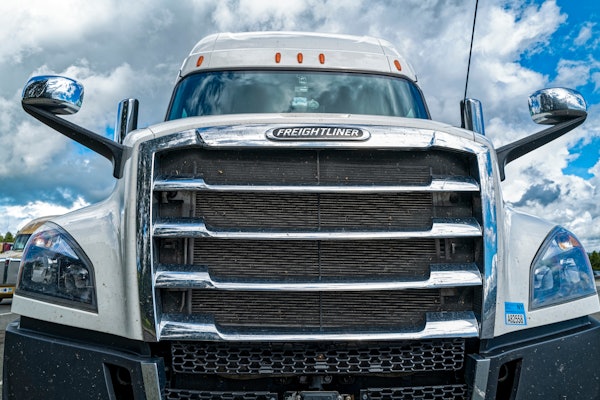Coolant and anti-freeze: there’s absolutely no difference between the two unless you’ve spent all winter unbalancing yours. A good preventative maintenance schedule doesn’t relegate coolant maintenance to just a seasonal thing, but if it’s your seasonal thing, it’s time to get started.
Contents of this video
00:00 10-44 intro
00:30 Coolant or anti-freeze?
01:22 Checking the cooling system
02:43 Topping off coolant
05:24 Using the right coolant
06:43 Adding water to coolant
08:14 Refractometers and other coolant testing methods
09:37 Meaning of coolant color
Jason Cannon (00:00):
CCJ's 10-44 is brought to you by Chevron Delo Heavy Duty Diesel Engine Oil. Now there's even more reasons to choose Delo.
(00:09):
Coolant and antifreeze there's absolutely no difference between the two unless you've spent all winter unbalancing yours. You're watching CCJ's 10-44, a weekly webisode that brings you the latest trucking industry news and updates from the editors of CCJ. Don't forget to subscribe and hit the bell for notifications so you'll never miss an installment of 10-44.
(00:30):
Hey everybody. Welcome back. I'm Jason Cannon and my co-host is Always on the other side is Matt Cole.
(00:35):
Engine coolant is one of the most neglected fluids on a tractor mostly because, unless there's a leak, it probably takes a long time for it to cycle onto your PM schedule. Outside of a pre-trip inspection, coolant generally gets a seasonal check. And that's not really enough.
Matt Cole (00:49):
It may seem like since temperatures are climbing, antifreeze is less important. And the antifreeze properties probably are less important. But its ability to cool the engine are going to get a little more important every day now that we're in spring and headed into the summer.
Jason Cannon (01:03):
A good PM schedule doesn't relegate coolant maintenance to just a seasonal thing, but if it's your seasonal thing, it's time to get started. Chevron Lubricants Commercial Fleet's business consultant, Shelly Eckert joins the 10-44 this week, and she wants to remind us all that there's a lot more to a healthy coolant system than just the fluid.
Shelly Eckert (01:22):
You do check for leaks. You do check for loose hoses and clamps and the radiator cap. The best practice is to pressure check the cooling system. If you pressure check the cooling system, you're going to know whether or not that cooling system is holding its pressure.
(01:38):
The other thing is you can do a visual from the outside of the cooling system to look at the color. However, the dye tends to leach into the plastic of the sump. So best is to take a visual by opening up the radiator cap and looking down. Pop the hood, and you do the first thing as a visual assessment. And you want to make sure that the coolant is at the fill line. If it's below, then you clearly are losing coolant. Then that could be water or it could be water and glycol. So if you're not retaining the pressure of the cooling system, you are likely boiling water off. So one of the things you can look for is also streaming on the outside of the radiator cap because if it's boiling off water, it'll stream out and it'll cause salt trails on the outside of the overflow tank.
(02:26):
One of the reasons why I start with a visual inspection on the cooling system is because sometimes you'll get oil into the coolant and you can see that oil layer floating on top of the sump. And, typically, if you've got oil in the coolant, you've got coolant in the oil, and then you've got big problems.
Matt Cole (02:43):
Let's say sometime over this winter you found a leak. There's any number of off-the-shelf products you can pour into the coolant system to help stop it. The problem with those are one, you've not actually fixed the leak, and two, you've unbalanced your coolant with a foreign additive. That's not going to help prevent the freezing or cooling of the engine.
Shelly Eckert (02:59):
I would just top it up with water. And the reason for that is because if you don't know what the coolant is in the cooling system, water is always going to be in the cooling system. You're going to diminish the amount of protection, but it will buy you time to get into a shop to get the cooling system fixed.
Jason Cannon (03:18):
Hoses dry rot all the time and clamps fail. It's really common to find a coolant system leak at some point, so top-offs are not all that unusual. But Shelly says, it's not as simple as just dumping more coolant in. You need to know what's in there before you top it off. And if you don't know, Shelly says there are better and cheaper options than just rolling the dice on a new jug at the truck stop anyway. She tells us what that is after a quick word from 10-44 sponsor, Chevron Lubricants.
Announcer (03:45):
These past few years have been less than easy. We've encountered challenges we never imagined we'd ever have to deal with. From makeshift home offices and video meetings to global supply chain uncertainty, price instability, market disruptions, and everything in between.
(04:02):
Delivering the level of services and products our customers had come to expect was difficult for all of us. We can't change what's behind us, but we can definitely learn from it. We can adapt, evolve, and take steps to reset our thinking, adapt our strategies, and restore your trust in us to better meet your needs now and in the future. That change begins today.
(04:27):
Today, we break with convention and introduce a rebalanced line of Delo heavy-duty engine oils. We've reduced our product line from four categories to two. Consolidated and simplified, this lineup removes complexity from the manufacturing processes, enhancing price stability and supply chain reliability so you can trust you will have the premium products you need to keep your business always moving forward.
(04:57):
Our break with convention optimizes the Delo lineup to allow you to provide your customers with the best synthetic blend and synthetic heavy-duty engine oils in the market, fully available at prices you can rely on. It's your assurance that you'll be well positioned to be their trusted source for proven engine protection that keeps equipment on the job, giving your customers even more reasons to choose Delo.
Shelly Eckert (05:24):
The general principles of coolant is that you've got a variety of different coolant types, and you've got to make sure you're using the right type of coolant. Whether you started with conventional as the coolant being used, fully formulated, a hybrid coolant, or a full extended life coolant, you got to know what you're using.
(05:47):
If you are not aware of what you're using and you just need a quick fix to get back to a shop, your best option is just to top it up with water, especially during the summertime, it's kind of a gamble to do it during the winter because we originally when we started cooling these engines down, we originally started with water back in the day. But it needed to adjust to the variety of temperatures that we have in the world, which is why glycol was introduced, so it would lower the temperature tolerance.
(06:19):
In fact, today you still use water in places like Hawaii or the Gulf of Mexico, southern places of the country where you really don't need the glycol. You still should use additives, so you can use a product that has the organic acids that you just pour into the water 'cause you don't need the glycol. So it's different chemistry.
Matt Cole (06:43):
Any good maintenance professional knows how important glycol is for antifreeze protection, but it's probably not as widely understood how critical water is and the purpose it serves. Water isn't just diluting the glycol, it's actually what's cooling the engine and, believe it or not, there are OEM recommendations for water.
Shelly Eckert (07:00):
When we blend a coolant, the first thing that we do is it's just the glycol. It starts with the glycol, then you put the additives in the glycol. And then, you have a concentrate product at that point where it's fully glycol. And some customers will use a concentrate coolant. I'm a big believer of just staying with the D50, which is the mix of the water with the glycol. And the reason why I coach on that is because water is not always the same.
(07:28):
So we blend a 50/50, we're using deionized water, and you can use that using the osmosis system to do that, but that's getting high-tech. So in the field you look for a distilled water. Bottled water is the best thing. Using tap water is questionable, especially in certain states where our water system is not exactly up to speed or kept up-to-date. Water coming out of a hose is probably even worse.
(07:56):
So, for example, Detroit Diesel lists out in their service bulletin the requirements of the water, so it can only have so much chlorides, so much sulfate. That's all in the requirements of a good coolant, and what water you're using, but water is the best heat transfer product.
Jason Cannon (08:14):
Nobody tops off just for fun, you do a top off to solve a problem. But even if you're using 50/50 as a top off, you're probably still unbalancing your coolant. That's why you have to test it regularly.
Shelly Eckert (08:25):
The best practice to check to see what's going on with that balance is to use, what we call, a refractometer. You can get them on Amazon, Amazon Prime, or you can go to your oil supplier, they usually have them. And it's really simple to use. You just literally open up the shield to check to make sure it's reading correctly. You use just water, and then you just wipe off the water, and then you put a couple drops of the coolant on there, and you're going to know by looking through the eyepiece what is the freeze point.
(08:56):
For example, if this is not reading correctly, there is an adjuster knob on top of a refractometer, typically. Not all of them, but typically, and you just would take a little screwdriver and adjust that knob to move the line inside on the chart up or down. That's my number one tool. There are other things on market such as test strips that will read a freeze point as well. My preference is to use exactly what the labs use, which is a refractometer. There's also really inexpensive hydrometers but, over time, those hydrometers, they get contaminated.
Matt Cole (09:36):
Shelly earlier mentioned the color of the coolant but, interestingly enough, color means nothing at all unless it's brown.
Shelly Eckert (09:43):
Brown means bad. That could be rust, that could be two different coolants being mixed together. It just needs to be drained and flushed at that point. Everybody considers green as being conventional coolant. I know for a fact that there is a hybrid Japanese coolant that is here in the States that is green, so the color of the coolant means nothing.
Jason Cannon (10:04):
That's it for this week's 10-44. You can read more on ccjdigital.com. While you're there, sign up for our newsletter and stay up-to-date on the latest in trucking industry news and trends. If you have any questions or feedback, please let us know in the comments below.
(10:17):
Don't forget to subscribe and hit the bell for notifications so you can catch us again next week.










